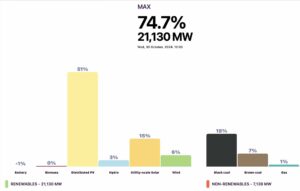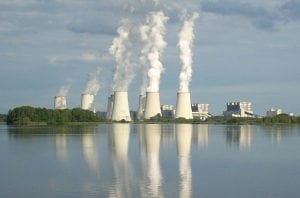If you follow the Minister for Coal Resources, Matt Canavan, you’ll see plenty of cheer-leading for coal:
Another report out today showing why it’s so important not to turn our back on coal. If you want cheaper power we have to use our energy resources! pic.twitter.com/kRn2yJLiAq
— Matthew Canavan (@mattjcan) July 16, 2018
Reading the Canavan’s tweets and Facebook posts, you’d be forgiven for thinking that AEMO’s much awaited Integrated System Plan says, well, that coal is ‘king’ and will rule for the next 20 years.
But does AEMO actually say that? Here’s a chart showing the relative share of coal, gas and renewables over the next 20 years under the ‘neutral’ scenario.
The ‘neutral’ scenario assumes nothing more than committed projects, the tail end of the RET, the state targets (VRET and QRET) and Frydenberg’s desultory NEG. The ‘neutral’ scenario sees renewables overtake coal sometime in 2032, coal declines from 68% to 22% of the NEM, renewables grow from 24% to 72%. So much for coal reigning supreme!
The chart demonstrates very well that gas, while remaining extremely useful to the energy transition, does not need to increase in order to retire coal — in fact AMEO’s neutral scenario shows gas contributing 8% of electricity in the NEM this financial year and never again exceeding 6%.
(Ordinarily I’d change the colours for the series above, but the defaults were so pretty that I left them as is!)
It should be noted that AEMO’s modelling algorithmically determines the least cost solution that delivers a mix that meets the scenario’s reliability, security and emissions goals. As such, the scenario is a rigorous, dispassionate and optimal solution to the ‘trilemma’ of cost, reliability and emissions.
So what about the other scenarios? What happens if we adopt a ‘fast’ scenario, which assumes strong economic growth, strong electric vehicle uptake and a 52% emissions reduction across the period 2005–2030 (consistent with CSIRO’s Low Emissions Technology Roadmap)?
The ‘fast’ scenario brings forward Australia’s energy transition such that renewables surpass coal in 2026, some six years earlier:
The ‘neutral with storage’ scenario includes the construction of Snowy 2.0 and the Tasmanian ‘Battery of the Nation’ projects. (These are excluded from the ‘neutral’ scenario as the two large pumped hydro projects have yet to achieve ‘final investment decision’). While both projects will no doubt be very handy, AEMO’s modelling shows that the projects won’t have a significant impact on the pace of our energy transition:
AEMO’s scenarios yield a range of growth rates for renewables, and apart from the ‘fast’ scenario, there’s very little to separate them in the decade to 2030. An ‘increased role for gas’ scenario shows that renewables will not fare as well in following decade if gas reduces “significantly in price from current expectations (around $8-10 a gigajoule [GJ]) to around $6/GJ”.
Whichever scenario plays out, we can see very significant reductions in emissions, though, unsurprisingly, progress is retarded if we turn to gas. (Note that this chart is derived from AEMO data and uses an average emissions intensity for each technology, rather than facility level emissions intensity — an approximation for expediency.)
So if thermal coal is in terminal decline in Australia, there’s still a bright future for our coal overseas, right? It’s been booming, right?
Well, not according to official figures from the Office of the Chief Economist. Data from their June report shows that export quantities are flat:
But Canavan has been telling us that coal is booming, right?
Dont believe the “boy who cried wolf” crowd who keep talking down coal. Record $60b in coal exports last year and next year coal will overtake iron ore as our biggest export. Great for jobs! pic.twitter.com/3UVySvOtBS
— Matthew Canavan (@mattjcan) July 2, 2018
Yes, coal (thermal and metallurgical coal) is expected to our largest export this financial year, but it doesn’t sit right with me to claim a 15% reduction in value over two years as a “win”. Any coal workers taking out a mortgage on the back of the Minister’s exuberance will have a right to be livid when their employer cuts back production.
So is this talk of ‘structural decline’ of thermal coal just propaganda by activists, or is it for real?
A couple of data points: Due to the high sulphur content of much of Australia’s apparently ‘clean coal’, South Korea’s June imports of Australian coal were down 27% compared with last year, and more ominously for the global thermal coal sector, India’s imports for the last quarter are down 16% on last year. But some might argue that this are just blips. Maybe, maybe not.
Global thermal consumption peaked in 2013. Last year saw a the first (slight) increase after three years of decline. It’s too early to tell if this was a reversal or just ‘noise’, but given the technology drivers —so clearly demonstrated in AEMO’s ISP — my bet is on a long, slow structural decline.
Of course, to give us a fighting chance of a safe climate, the inevitable demise of coal needs to accelerate significantly.
Simon Holmes à Court is senior advisor to the Climate and Energy College, Melbourne University and can be found on Twitter @simonahac


















